What is a ‘Garden’?
“a garden is the purest of human pleasures; it is the greatest refreshment to the spirits of man; without which buildings and palaces are but gross handiworks” – Francis Bacon, Of Gardens, 1625
The etymology of the word gardening refers to enclosure: it is from Middle English gardin, from Anglo-French gardin, jardin, of Germanic origin; akin to Old High German gard, gart, an enclosure or compound, as in Stuttgart.

Stourhead Garden, Wiltshire, UK
Abstract
In experimental architecture and over the past decade, the formal recourse to continuity, generalized with the computational revolution of the 1990s, has shown symptoms of exhaustion. In its place, and together with a powerful cross-disciplinary cultural movement, various architectural currents have tried out a reintroduction of the discrete – although the disciplinary impact has been, for the most part, largely cosmetic. The aim of this research is to analyze The Eden Project in Cornwall, UK, designed by the Grimshaw Architects in the light of “A Garden in Movement” by Gilles Clement. In this process, we also try to analyze four items/events occurring around the timeline of this project and the ideologies and philosophies that not only have led us to the project but also that have raised from the project. We also present the findings of this research based on The Eden Project, and finally conclude with our inferences of this research.
Introduction

Gilles Clement, in his book “Le Jardin en Mouvement” (The Garden in Movement) describes a garden inspired by neglected land (friche): a parcel of land left behind (délaissé) to the unhindered development of those plants that settle there. On such pieces of land, he says, “the existing sources of energy – growth, struggle, shifting, exchange – do not encounter the obstacles usually set up to oblige nature to yield to geometry, to tidiness, or any other cultural principle. This energy encounters the gardener, who attempts to shape it to his advantage without altering its dynamics.” It propagates the practice to do as much as possible for as little as possible against, which in itself is the fundamental philosophy of a Garden in Movement.
The name Garden in Movement originates in the physical migration of vegetal species within the garden, which the gardener interprets at will. Flowers which germinate on a path force the gardener to decide between maintaining the flowers or the path and many more. The Garden in Movement thus recommends maintaining those species that decide where they wish to grow.
The culture of gardening reaches deep into antiquity, when Alexander the Great was reportedly awestruck by the magnificence of Babylon’s gardens. Homer tells of the Garden of Alcinous, its fertility and symmetry of form. The Romans were known for planting their gardens with the riches of Asia. Gardening was not recognized as an art form in Europe until the mid 16th century when it entered the political discourse, as a symbol of the concept of the “ideal republic”. Evoking utopian imagery of the Garden of Eden, a time of abundance and plenty where humans didn’t know hunger or the conflicts that arose from geographical disputes. During the era of Enclosures, the agrarian collectivism of the feudal age was idealized in literary “fantasies of liberating regression to garden and wilderness”.
Eden Project
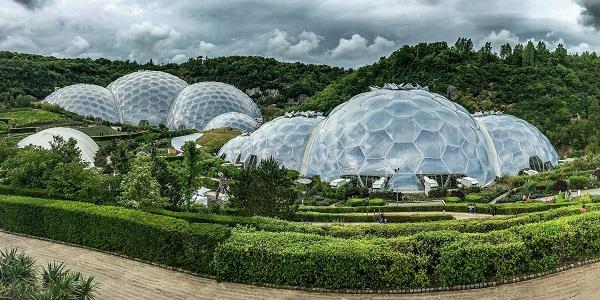
The Eden Project, Cornwall, UK
The Eden Project is a visitor attraction in Cornwall, England, UK. Inside the two biomes are plants that are collected from many diverse climates and environments. The complex is dominated by two huge enclosures consisting of adjoining domes that house numerous plant species. These two enclosures emulate two diverse natural biomes. The biomes consist of hundreds of geodesic hexagonal and pentagonal steel trusses, infilled with ethylene tetrafluoroethylene (ETFE) inflated cells. The largest of the two biomes simulates a rainforest environment (largest indoor rainforest in the world) and the second, a Mediterranean environment. The attraction also has an outside botanical garden which is home to many plants and wildlife native to Cornwall and the UK in general.
The Eden Project was set in the time of generating awareness about sustainability and rational living. This pit to paradise01 ethos of the project shines through not only the programmes run at this facility, but also in its core design principles. This project repurposed a non-functional china-clay pit into a botanical garden. It actively runs outreach and awareness programs to educate people about sustainable living principles, natural resources and more.
This movement in ideologies is also evident in other disciplines, creative and otherwise, and through this research we analyse these “items of influence” in light of the The Eden Project.
Flashback : Events that influenced the creation of Eden Project
Socio-Political Event : The Earth Summit, Rio de Janeiro, 1992
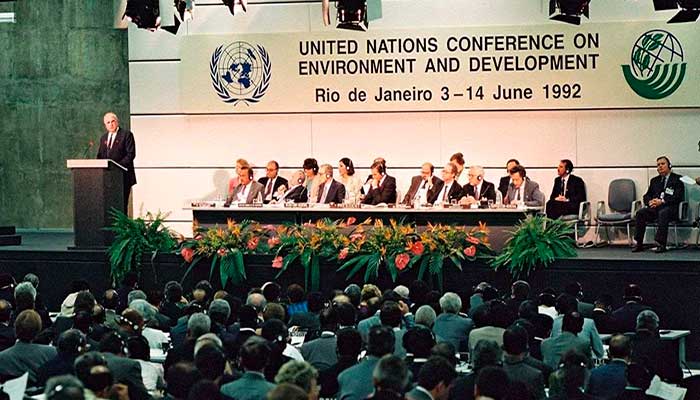
The Earth Summit 1992 at Rio de Janeiro was the largest gathering of the world leaders, with 117 heads of states and representatives of 178 nations gathered solely to take decisions for the betterment of the nation and the environment.
As the entire world was recovering from the Cold War, Recession and Declining Economy. Many defining events were happening including the Dot-Com Burst, Resignation of longest serving Prime Minister of UK- Margaret Thatcher, the formation of Schengen Space. There were many effects of globalization that affected the environment too. Heavy dependence on fossil fuel was increasing along with deforestation creating a large concern on climate change.
The Earth Summit consists of a number of documents namely- Agenda 21, Rio Declaration on Environment and Development also Forest Principles. The summit also resulted in the nations signing binded agreements of Convention of Biological Diversity, Framework Convention on Climate Change and United Nation Convention to Combat Deforestation.
One of the important signings was the Convention of Biological Diversity, where the nations agreed upon conservation, restoration and sustainable use of the biological components. The agreement also includes the sharing of the biological advancements with the member nations and to use the resource in a more equitable and sustainable way. This also gave rise to the term Biodiversity Banking.
We can better analyze the Earth Summit with the following excerpts from the article by Professor Celso Lafer in CBD 10th Anniversary Magazine-
“…the centripetal forces of globalization (such as market trends, societal values and communication networks) and the centrifugal forces of fragmentation (of national and cultural identities, the erosion and affirmation of sovereignties) operating in a post-cold war world made it even more difficult to consolidate the “vision” contained in the “Spirit of Rio” in favor of a new launching ground for international coexistence.”
The Eden Project’s mission is to ‘promote the understanding and responsible management of the vital relationship between plants, people and resources, leading towards a sustainable future for all.’ Sustainable development is at the heart of the Eden Project, where the aim is to work towards understanding and implementing Agenda 21, the ‘Convention on Biological Diversity’ and the ‘Framework Convention on Climatic Change’ agreed upon at the Earth Summit in Rio in 1992.
Technology Device : ETFE Cushion System
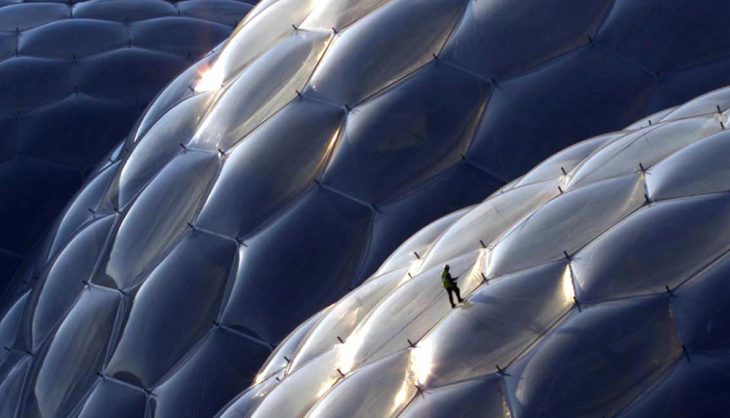
Hexagonal ETFE Cushion
The Eden Project was one of the first buildings designed for the ETFE cushion system. It presents itself as an enclosed garden within three different biomes. Thus, it contrasts with Gilles Clement’s idea of a garden in motion with no physical limits or boundaries. Nevertheless, the ETFE cushions that fill the Eden Project structure can be detached easily from the steel frame. Thus, the structure could be expanded and developed in the decades to come. On the other hand, several aspects of the two types of gardens share the same ideals. The idea of transformation that Gilles Clement attaches to the garden in movement can be found in the Eden Project. Clement’s idea of the garden is a land where the images change frequently (which is why it is called the garden in motion), where there are plants that are always there and others that travel. The Eden Project is a fully functioning greenhouse, but its creators consider it a work in progress, and they wanted it to evolve naturally. They added new plants all the time. In spring 2001, they introduced exotic butterfly species to the enclosed biomes. Only male butterflies to avoid a population boom that could affect the plants. In light of this, the Eden Project agrees with the garden in movement’s main principle, making the maximum in favor and the minimum in contrast.
The application of cushions on the Eden Project’s biomes’ geodesic structure was an ideal solution to maximum transparency for plant growth combined with the minimum number of structural elements. Each biome features a hexagonal frame infilled with ETFE. Although repetitive, each ETFE cushion is unique in numbers of foils and thicknesses. The whole structure and skin weigh less than the biomes enclosed air, which has to be considered a high environmental efficiency achievement.
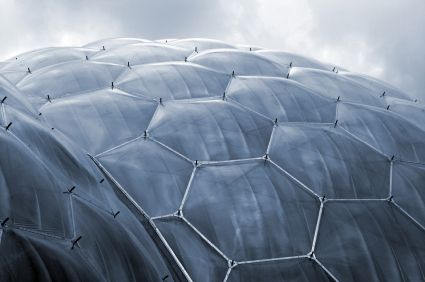
ETFE was the result of DuPont’s research program that aimed to develop a resistant material to friction and abrasion for industrial machinery and which could support both extraordinarily high and low temperatures. During the oil crisis in 1973-74, the architectural interest in ETFE spread as Europe was concerned about harvesting solar energy to replace fossil fuel.
This material has sustainable attributes and several environmental advantages. First of all, it is a low-maintenance material of its resistance to atmospheric pollution and ultraviolet light degradation, and it is also self-cleaning. Secondly, compared to glass, it requires lower energy production, which is less than 1%. Furthermore, the lightweight allows it to be compacted and economically transported to be inflated once installed on-site.
Artwork : “Earth, Water, Willow Withy, Blade of Grass, Rowan Berries, Privet Berries” by Nils Udo
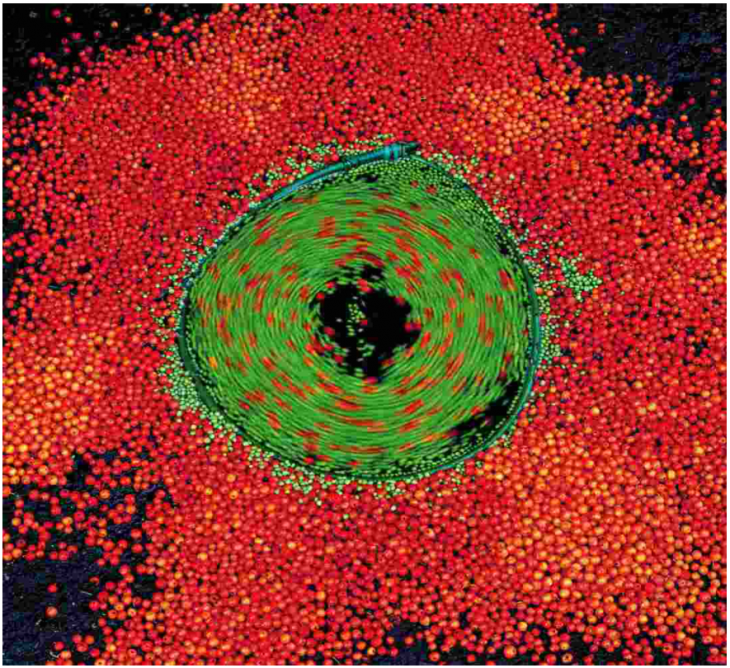
Art in Nature, Nils Udo, 1999
Nils Udo is a German artist who has been creating environmental art since the 1960s. Over time he moved away from the traditional canvas and started working with and in nature.
The artwork “Earth, Water, Willow Withy, Blade of Grass, Rowan Berries, Privet Berries” by Nils Udo in 1999 depicts the constant pressure faced by nature due to humankind’s actions. The artwork represents the formation of complex connections between different species protected within a bubble.
As in the Eden Project, which aims to make people aware of plant resources’ sustainable use and the effects of the ever-growing modern world’s pressures, Nils Udo’s artwork, through the symbolic use of natural elements, aims to raise awareness about harmful actions of mankind. Moreover, the use of water, blades of grass, and privet berries set on the backdrop made of earth symbolize the ideation of nature as being omnipresent through everything.
Clement talks about the importance of diversity and the complex connection between different species when it is free from human interference is also something that Nils Udo abstractly portrays in this artwork through the use of different materials which give out different characteristics.
Even though the Eden Project and Garden’s in Movement are completely different in terms of execution. Fundamentally, they both share the same values that correspond to what the artwork is about.
Publication : “Cradle To Cradle” by William McDonough, Michael Braungart.

Cradle to cradle is a work made by William McDonough and Michael Braungart was first published in 2002. The authors tried to spotlight the way industry works today, which is damaging at its most fundamental ideological level. By rethinking recycling, respecting regional differences and incorporating ecology into your organizational structure both systems the environment and industry will become the one interdependent whole.
Moreover, the Cradle to cradle publication explains that the diversity of the plants is one of the main components of the beauty of nature. It raises the problem of people’s attitude towards flora conservation. The more different elements make up the ecosystem, the better the system’s internal metabolism will work. The processes that take place in this bio-metabolism are cyclical and inextricably linked to each other. In the Gilles Clement’s “Garden” concept is not a group of plants planted together within the limited territory. They are in motion and interact with each other. The author explains it in the publication: “Garden itself is not in the movement, but there are series of species that can move around.” Within the framework of this idea, the term metabolism is fully applicable and coincides with the vision and concept of the plant world by Cradle to cradle.
On the other hand, the physical form of Gilles Clement’s concept can exists just in a micro scale. Therefore It is quite locally applicable. The concept almost completely excludes human interaction and creates an environment for plants which is similar to the wild conditions. It is in contrast to «Cradle to cradle» publication, where the idea of the harmful impact of global industrialization and human nature is taken as a basis. The book’s main idea is to change the approach to production and industry in general and completely eliminate the harmful effect on nature. The authors explain what a “nutrient flow” is. They talk about the biological and industrial metabolisms as the one whole: “Waste Equals Food”. Thus, human beings in this bio-metabolism are an integral part of the process, that is in interaction with the surrounding.
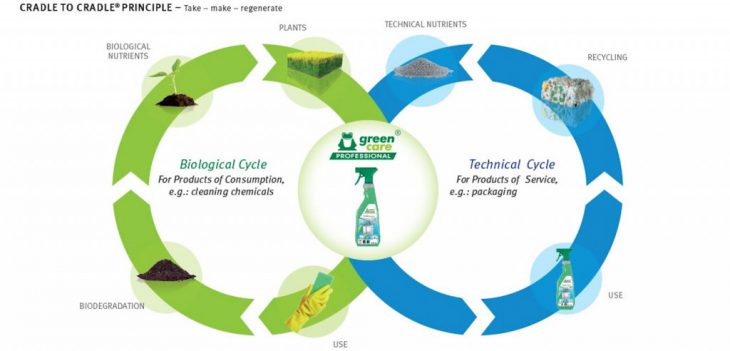
The parallel idea could be seen in the Eden project where nature and visitors interact in the same way, but only from the human side. It proceeds through an emotional and informational level inside of the project. The interaction between the project and nature takes place on a different level in the global sense. The project itself has been built using energy-efficient materials and technologies, which makes it partly closer to the credo concept. Wind generators and rainwater, an energy control system, etc., but the complex does not fully meet the requirements for an ideal Cradle to cradle main concept.
Finally, the Eden Project in the nutshell is a space where the large amount of plants from different parts of the world were collected under one roof. Therefore the project gives an opportunity for people to get into close contact with diverse representatives of flora and supposedly make them rethink on attitude towards nature in the global sense. Even though the objects of research of these works are different things. All three works were made in order to start a debate on a new vision of landscape culture, environmental issues and diversification of flora.
Conclusion
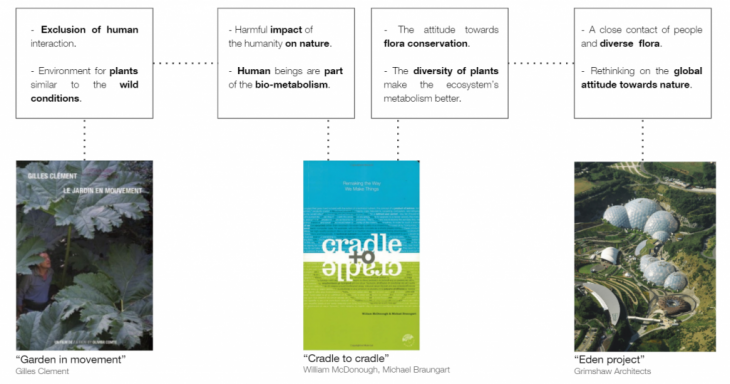
wwwwwwwwwwwww
References
Le Jardin en Mouvement, Gilles Clement, 1991
Le Jardin Planetaire, Gilles Clement, 1999
https://grimshaw.global/projects/list/the_eden_project/gallery
Cradle to cradle: Remaking the way we make things,
William McDonough and Michael Braungart, 2002
Annette W. LeCuyer, Ian Liddell, Stefan Lehnert, Ben Morris, ETFE: Technology and Design, Walter de Gruyter GmbH, 2008
A.A.School of Architecture, “Gilles Clement – From the Garden in Motion to the Third Landscape”, Youtube Video, 14:14, Feb, 20 2007,
University of California Television (UCTV), “UCSD by Design: Gilles Clément”, Youtube Video, 46:21 , Mar 17, 2011,
The Eden Project : A Garden in Movement is a research project of IaaC, Institute for Advanced Architecture of Catalonia developed at the Master in Advanced Architecture in 2020 by:
Students: Shubham Dahedar, Laukik Lad, Elena Petruzzi, Aqeel Sourjah, Matvei Genne
Faculty: Manuel Gausa, Jordi Vivaldi Piera